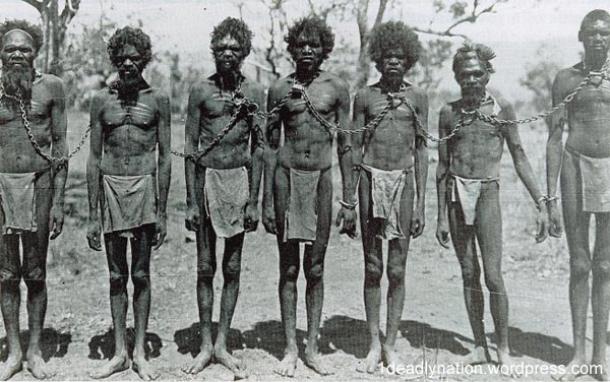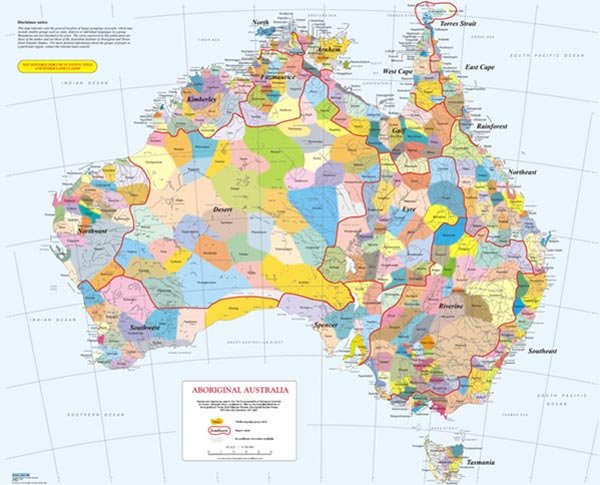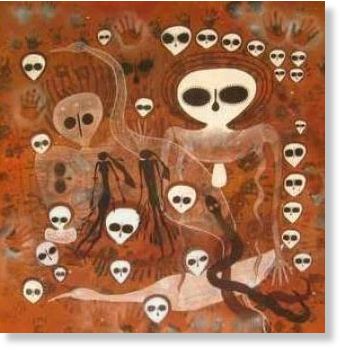
© UnknownAustralian aborigines in chains.
As an Australian, I have fond memories of Australia Day celebrations. I would sit on my father's shoulders waving my Australian flag as we watched hundreds of boats crowd the harbour. I was always taught that Australia Day was a day to celebrate the beginning of a great country. At school it was the same - I recall colouring pictures of a heroic captain proudly planting a flag in Australian soil. Little did I know at the time, that the beginning of this 'great nation' was the end of another.
26th January - A day to celebrate? Australia Day is celebrated on 26
th January because it is the day that
Captain Arthur Phillip and the First Fleet, made up of eleven convict ships, landed at Sydney Cove in Australia and raised the British Flag, marking the beginning of British sovereignty over Australia. Phillip took possession of the land in the name of King George III, a land that had been declared terra nullius (uninhabited by humans).
In schools and in most history books, Arthur Phillip is described as a kind man who had a "friendly attitude towards the Aborigines", and for a short period of time he did. However, what is not taught is the fact that
Phillip's tolerance was short lived. After his game keeper, John McIntyre, was killed by Aborigines (John McIntyre was a brutal man who hunted Aborigines as well as animals), Phillip ordered the capture of any two Aboriginal men found in the region, and that ten more should be killed. The heads of the slain were to be cut off and brought back to the settlement for public display. In his own words, he was "determined to strike a decisive blow, in order at once to convince [the Aborigines] of our superiority, and to infuse a universal terror." He also later ordered his men to shoot at Aboriginal people to keep them away from the British settlements.
This is the 'hero' who is now honoured with a statue in Sydney's Botanic Gardens.Different perspectives, different meaningsTo Australian's today, the 26
th January is a day that is intended to represent how far Australia has progressed and to celebrate the positive aspects of Australian society, to recognise those who have made important contributions to society, and an opportunity to be proud of how Australia had flourished since the early days of settlement, to reach its present state as a democratic nation.
However, for indigenous Australians, the 26
th January, much like
Columbus Day in America, is a reminder of the decimation of their people and the loss of their land, their culture and their basic human rights. The Australia Day celebrations of 1938 (150
th Anniversary) were accompanied by an Aboriginal
Day of Mourning, and in 1988 (200
th Anniversary), many indigenous people made a concerted effort to promote an awareness among other Australians of their presence, their needs and their desire that there should be communication, reconciliation and co-operation.
An ancient culture spanning thousands of yearsThe Aborigines, who now make up only 3% of Australia's population, are the original inhabitants of the Australian continent and are believed to have migrated from Africa to Asia
around 75,000 years ago, and arrived in Australia around 50,000 years ago. However,
some researchers have said their culture is much, much older. The Aboriginal culture is in fact the oldest continuous living culture on the planet.
There were about 600 different clan groups or 'nations' around the continent when Europeans arrived, many with distinctive cultures and beliefs, and there were over 250 - 300 spoken languages with 600 dialects. All but 20 of those dialects have virtually died out. The map below is just one representation of other map sources that are available for describing Aboriginal Australia. This map indicates only the general location of larger groupings of people which may include smaller groups such as clans, dialects or individual languages in a group.

© ABC Online
The hallmark of Aboriginal culture is 'oneness with nature'. Out of a deep reverence for nature Aborigines learned to live in remarkable harmony with the land and its animals. Prominent rocks, canyons, rivers, waterfalls, islands, beaches and other natural features - as well as sun, moon, visible stars and animals - have their own stories of creation and inter-connectedness. To the traditional Aborigines they are all sacred.
The Aborigines lived a nomadic life, following the seasons and the food. They learned to live in the harsh and inhospitable Australian outback. When at rest, Aborigines lived in open camps, caves or simple structures made from bark, leaves or other vegetation. Their technology was both simple and practical. Above all, it was appropriate for their way of life - ideally matched to the constraints of nomadic life.
The modern notion of possessions is alien to traditional Aboriginal culture. Material things were shared within groups.
The idea that an individual could 'own' land was foreign to Aboriginal thinking.Although lacking a formal written language, for thousands of years Aborigines have recorded their culture as rock art, which continues to the present day. Their art shows images of the environment, such as the plants and animals, including images of animals believed to have become extinct 20,000 to 40,000 years ago. Some of the most ancient paintings, in rock shelters in northern Australia, depict people dressed for ceremony and dancing, with similar body decoration and accoutrements to those worn in ceremonies to this day, again revealing the great age of Aboriginal culture.
The longest continuing religion in the worldThe longest continuing religion in the world belongs to Australia's Aborigines, with the
Rainbow Serpent mythology recorded in rock shelter paintings believed to be 7,000 years old in the Kakadu National Park region,
where this Ancestral Being is still important to local people today.
Other ancient rock art shows the many customs and Ancestral Beings (deities or gods) important in Aboriginal religion tens of thousands of years ago,
such as the Wandjina, the supreme spirit beings and creators of the land and people.
© UnknownRock art depicting the Wandjina
The Aboriginal belief system is known as 'The Dreaming'. It is a complex network of knowledge, faith and practices that derive from stories of creation, and dominates all spiritual and physical aspects of Aboriginal life, and which has different meanings for different Aboriginal people. The Dreaming sets out the structures of society, the rules for social behaviour and the ceremonies performed in order to maintain the life of the land.
In most stories of the Dreaming, the Ancestor spirits came to the earth in human form and as they moved through the land, they created the animals, plants, rocks and other forms of the land that we know today. They also created the relationships between groups and individuals to the land, the animals and other people.
Once the ancestor spirits had created the world, they changed into trees, the stars, rocks, watering holes or other objects. These are the sacred places of Aboriginal culture and have special properties. For Aboriginal people all that is sacred is in the land. Knowledge of sacred sites is learned through a process of initiation and gaining an understanding of Aboriginal law.
This is why the loss of land after the arrival of the British was so devastating for the Aborigines. Not only was 'possession' a foreign concept to them, but the land formed the very fabric of their culture and beliefs.
As more and more white settlers moved in and occupied the fertile lands the Aborigines were pushed further and further away from their traditional lands and into the harsh arid interior. Their families were broken up, their children taken away from them and sent to be "civilised", their sacred sites destroyed, many died of diseases, and others were killed.
Modern-day controversy - Australia Day or Invasion Day?Today there is much controversy in Australia surrounding the meaning and justification of Australia Day and these arguments resurface every year leading up to the 26
th January.
Many argue that Australia Day does not celebrate the beginnings of an independent nation - it celebrates the establishment of a British convict colony and the annexation of an inhabited continent. Others believe that Australians today should not be made to feel ashamed for actions committed by those who came before them and that attitudes and actions towards the Aborigines have changed significantly since the first days of colonisation. Where possible the government has been returning land to their traditional owners and encouraging Aborigines to rebuild their culture and lives. On the 13th February 2008 the former Prime Minister of Australia, Kevin Rudd, made a formal apology to the Indigenous Australians for their past mistreatments.
ReconciliationMuch progress has been made over recent years to try to right the wrongs of the past, and we should also be able to celebrate the things that we love about being Australian. But if we are truly to move forwards in reconciliation and what the Aborigines call 'Wiritjin' (Black Fella White Fella Dreaming together), then Australia Day should be on a day that all Australians - indigenous and non-indigenous - can feel joy in - a date that is significant to Australians in the 21st century, not one steeped in sorrow and regret.
I for one, will not be waving my flag today. But I hope that one day in the future, Australia may take the next step towards reconciliation by celebrating on a date that is positive for all.
Reader Comments
to our Newsletter